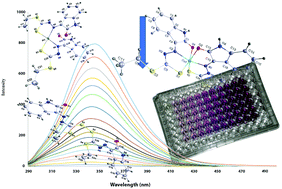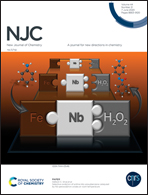Synthesis, characterization and bioactivity studies of new dithiocarbazate complexes†
Abstract
A new compound of the dithiocarbazate family, 2,2′-((disulfanediylbis((ethylthio)methylene))bis(hydrazin-2-yl-1-ylidene))bis(2-oxo-1,2-dihydro-3H-indol-3-ylidene), and its five metal complexes are synthesized. All compounds are characterized by elemental and mass analysis, spectroscopic (FT-IR, 1H-NMR and 13C-NMR) and TGA techniques. The crystal structure of the synthesized compounds is determined by single crystal X-ray diffraction analysis, which shows that the ligand acts as a tridentate chelate coordinated to Zn, Co and Ni ions in a distorted octahedral fashion and also as bidentate to Pt and Pd ions in a distorted square planar geometry. In order to investigate the compounds’ cytotoxicity, two human cancer cell lines of HeLa and MCF-7 are used and compared to the normal cell line of CHO. The clinical drug cisplatin is used as the standard drug. Fluorescence spectrophotometry is used to study the interaction of the compounds with human serum albumin (HSA) and parameters such as the Stern–Volmer quenching constant (KSV), the number of binding sites (n), association constants (Ka) and free energy changes (ΔG) at 298 K are calculated.



 Please wait while we load your content...
Please wait while we load your content...